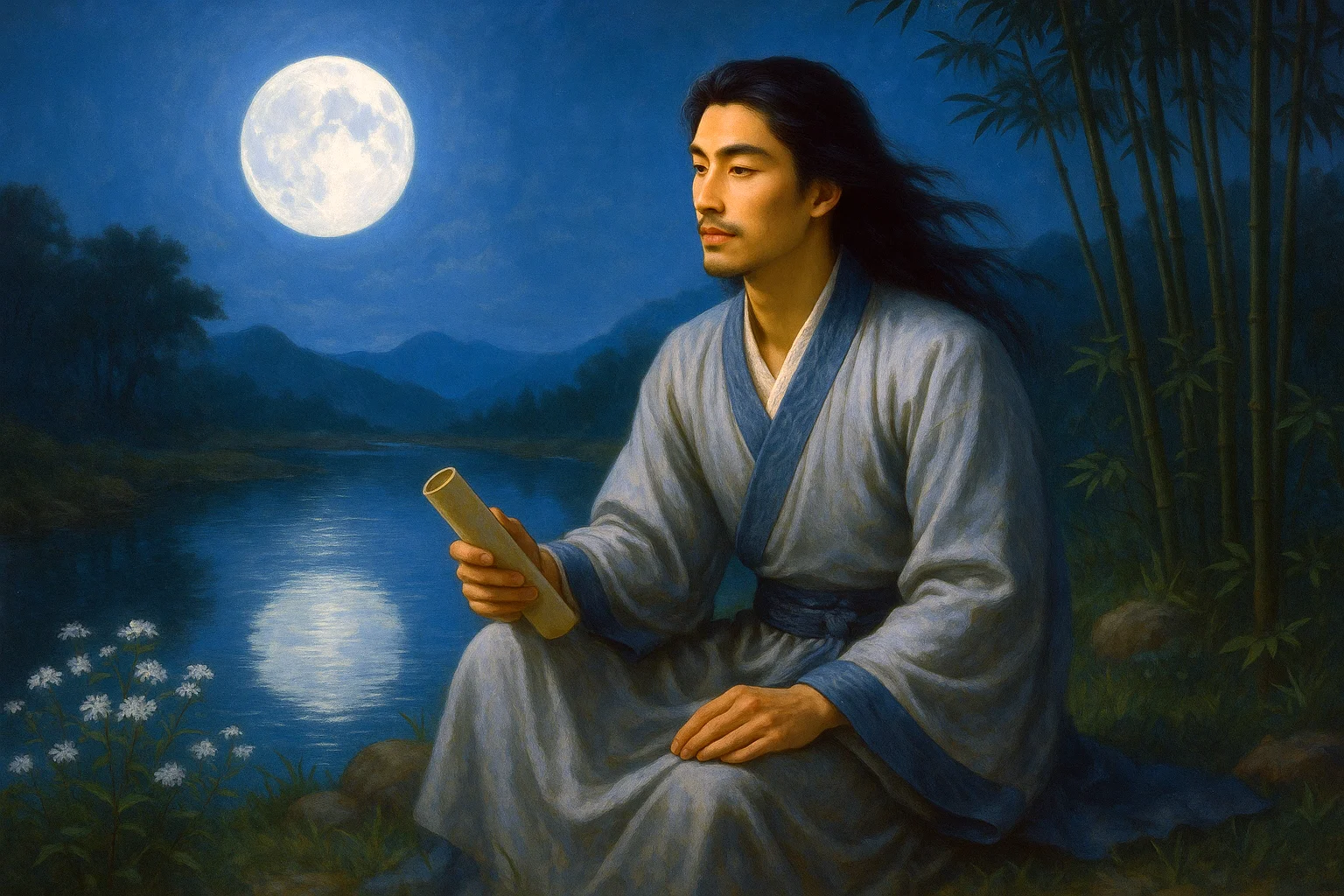New walls carve solar-lunar cycles deep,
Hall of Plenum stacks cliffs where sages sleep.
Autumn's momentum amplifies bronze vowels,
Buddha's jade throne parts cold clouds like towels.
Two streams flee toward twin gullies' oath,
Four mountains kneel to guard this growth.
Unicorn grass spells out south-east roads—
Pine gates gaze far with wisdom's loads.
Original Poem
「送觉祖院明上人」
曾巩
冠石新墙日月回,丰堂环殿起崔嵬。
钟随秋势金声壮,佛隐寒云玉座开。
流水远奔双涧去,平林高拥四山来。
麒麟细草南东路,一望松门意自哀。
Interpretation
This farewell poem was composed by Zeng Gong for Venerable Ming, a Buddhist monk departing from Juezu Temple. Through vivid depictions of the temple's majestic architecture and its harmonious natural surroundings, Zeng conveys both reverence for the monastic environment and profound human attachment. The work exemplifies his signature fusion of scene and sentiment, where spiritual grandeur and personal emotion intertwine.
First Couplet: "冠石新墙日月回,丰堂环殿起崔嵬。"
Guān shí xīn qiáng rì yuè huí, fēng táng huán diàn qǐ cuīwéi.
Crowned by boulders, new walls greet the sun and moon's eternal course; / Grand halls encircle the shrine, their towering peaks a sacred force.
The couplet establishes sacred temporality ("sun and moon's eternal course" 日月回) and spatial grandeur ("towering peaks" 崔嵬), framing the temple as both timeless and monumental. The "new walls" suggest perpetual renewal amid cosmic constancy.
Second Couplet: "钟随秋势金声壮,佛隐寒云玉座开。"
Zhōng suí qiū shì jīn shēng zhuàng, fó yǐn hán yún yù zuò kāi.
Autumn-charged bell tones boom with metallic might; / Buddha emerges from chill clouds on jade throne bright.
Sensory richness prevails: the seasonal "autumn-charged bell tones" (秋势金声) vibrate with metallic resonance, while the visionary "Buddha emerges" (佛隐…开) materializes through atmospheric veils, blending auditory and visual epiphany.
Third Couplet: "流水远奔双涧去,平林高拥四山来。"
Liú shuǐ yuǎn bēn shuāng jiàn qù, píng lín gāo yōng sì shān lái.
Streams race through twin ravines toward distant ends; / Level woods embrace four mountains as friends.
Nature's dynamic geometry unfolds: horizontal watercourses intersect with vertical mountain embraces, creating a mandala-like pattern that mirrors Buddhist cosmology. The "four mountains" (四山) may symbolize the Four Noble Truths surrounding the monastic clearing.
Fourth Couplet: "麒麟细草南东路,一望松门意自哀。"
Qílín xì cǎo nán dōng lù, yī wàng sōng mén yì zì āi.
Kirin-trodden grasses line southeast trails; / One gaze at pine gates - sorrow prevails.
The mythical kirin's (麒麟) implied passage sanctifies the departure path, while the final "pine gates" (松门) become emotional coordinates where spiritual and human attachments converge. The understated "sorrow prevails" (意自哀) resonates with Buddhist impermanence.
Holistic Appreciation
Comprising just four lines and twenty-eight Chinese characters, this poem is structurally clear and seamlessly blends scene with emotion. The first two lines depict scenery—snow melting to reveal mountains, transitioning smoothly into spring breezes bringing warmth—creating a fluid artistic conception. The latter two lines shift to sentiment, where "radiant blooms" (烂漫) evoke anticipation for flower-viewing, naturally introducing the theme of friendship with "companions awaiting blossoms" (看花人). The poet deftly intertwines early spring landscapes with inner joy, capturing not only the beauty of the season but also the harmonious state of "spring dwelling in the heart."
Written in plain, fresh language with vibrant imagery and a leisurely tone, this occasional poem carries enduring charm, reflecting a scholar’s spirit untethered from worldly clamor, at ease in nature.
Artistic Merits
- Vivid Scenery, Meaning Beyond Sight
The opening couplet begins with snow-thawed mountains brimming with vitality, using "spirit" (精神) to animate the landscape, embedding stillness within motion. - Emotion Through Scenery, Fusion of Heart and World
The closing lines transform spring’s splendor—"apricot groves in full bloom"—into a medium for shared joy, where feeling and view intertwine. - Accessible Language, Refreshing Style
Unadorned yet luminous, the poem achieves a "painting within poetry, people within painting" naturalism.
Insights
This poem teaches us to find hope and beauty in ordinary landscapes. The poet uses nature’s renewal—snow yielding to spring—as a metaphor for renewal in our lives, urging us to cherish new beginnings and embrace seasonal vitality. By depicting "friends pledged to admire flowers together," he underscores the value of companionship, reminding us that a fulfilling life stems not only from nature’s gifts but also from human connection and shared wonder.
About the Poet

Zeng Gong (曾巩, 1019 - 1083), a native of Nanfeng in Jiangxi province, stands among the illustrious "Eight Great Masters of Tang-Song Prose." His writings distinguished themselves through an elegant classical balance, celebrated for their rigorous argumentation and refined literary craftsmanship. While his poetry embraced an artless subtlety, his prose achieved what critics hailed as "the very essence of purity" - an achievement that, though perhaps less dazzling than his contemporaries like Su Shi or Wang Anshi, earned him posthumous reverence as the founding master of the "Nanfeng Literary School."












